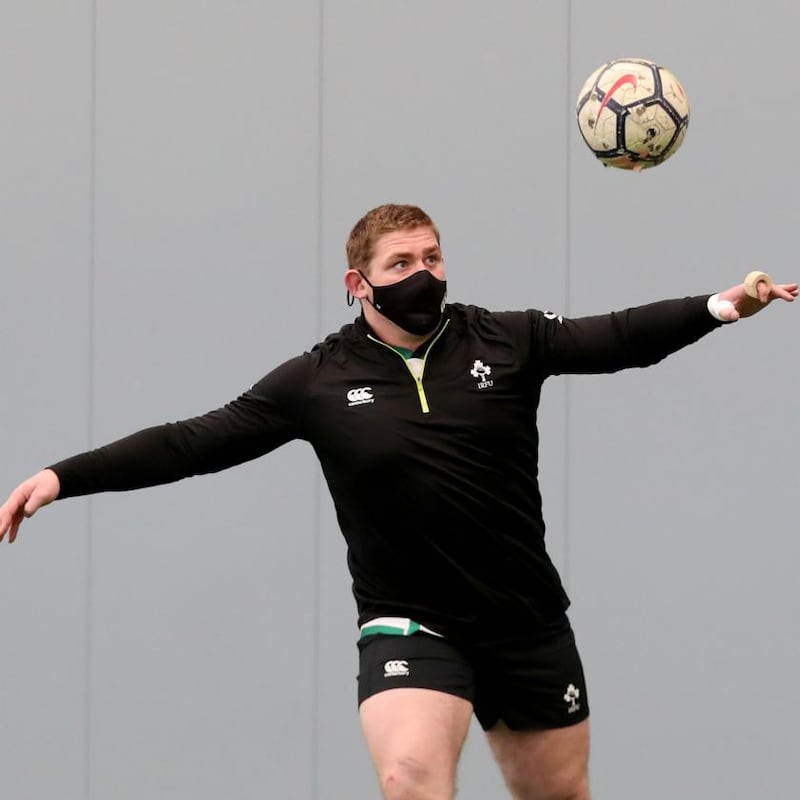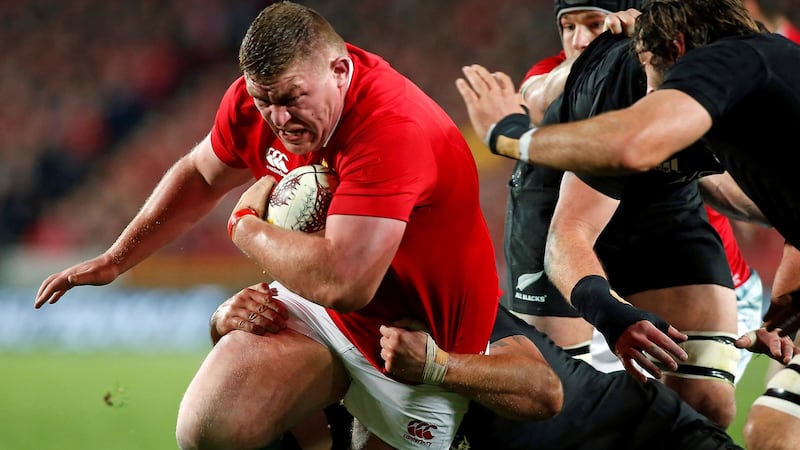For much of his 11 months on the sidelines, Tadhg Furlong couldn’t see even a glimmer of light but, with perfect timing, he’s emerged into the sunshine now. Today’s game marks a significant signpost on his road back, a third successive start and an opportune chance to seal a place in the Lions squad before also sealing his immediate future by agreeing a new two-year central contract with the IRFU.
Of the seven centrally contracted players, Furlong’s was always likely to require the longest negotiations given family and personal reasons had led to CJ Stander deciding to return home. No less than Stander, and perhaps even more so, even though he is Irish qualified Furlong would have real value for Top 14 or Premiership clubs.
After all, Furlong started all three Lions Tests against the All Blacks four years ago and, at 28, is probably entering the prime of this career and world-class tight-heads don’t exactly fall out of trees, especially in Ireland. But aside from knowing his value, Furlong had prioritised his return over his contract negotiations.
Ireland have been fortunate to have tightheads of the quality of John Hayes, Mike Ross and Furlong, and even more so that until the latter’s back and calf issues last year the three of them were so indestructible.
In the 22 editions of the Six Nations since the turn of the millennium, the aforementioned triumvirate have started 101 of Ireland’s last 109 games. Ireland have a winning percentage just shy of 70per cent with one of the trio, compared to a record of two wins, a draw and five defeats without them.
Now retired four years, Ross is still working in the software industry, switching to a new job as a sales director with Amdocs, an Israeli telecommunications software company which employs 25,000 people around the world, and whose clients include Vodafone Ireland.
“I was talking to him (Furlong) a month or two ago and he said the long lay-off gave him a chance to get proper pre-season in; eat the weights for a bit because he’s playing pretty steadily for the past few years,” Ross told The Irish Times this week.
Ross, who has no qualms in using the term "world-class" in describing Furlong
Indeed, since the 2015-16 season, Furlong has been on summer tours to South Africa, New Zealand (with the Lions) and Australia, as well as two World Cups.
Yet despite that, he has usually been restricted to 20-odd starts for province and country in any one season, along with three or four games off the bench. Even when including six appearances for the Lions four years ago, that brought Furlong’s tally for the 2016-17 season to 30 games, including four off the bench. This also underlines the value and attraction of staying in the Irish system.
“There’s a firmly joined up approach between the provinces and the union,” said Ross, who has no qualms in using the term “world-class” in describing Furlong, simply reasoning: “Who would you have ahead of him?”
No-one springing to mind, he concluded: “Well, that answers that question.”
It was only when watching Furlong’s contribution in the opening game off the bench against Wales that prompted Brian O’Driscoll to admit he’d forgotten what a good playmaker Ireland have at tighthead.
Ross recalls Furlong demonstrating those handling skills from the off, and cites a particularly eye-catching, try-scoring cameo off the bench in a win away to Cardiff when he’d just turned 22 in January 2015.
“It was a fast track but he was just all over the place. I was like ‘ah, I’ll have to watch out for this fella. It was like an oh s*** kind of moment. ‘I’ve seen the future and it doesn’t include me’.”
For a big man, aside from his now famed footwork, Ross also points to Furlong’s “explosiveness and turn of pace too.”
“There’s not too many people who have that complete package and offer what he does, never mind discussing those steps against Scotland,” says Ross of something which he declared: “It was absolutely disgusting. He should be ashamed of himself.”
Ah yes, Furlong’s balletic steps off his right foot to leave George Turner and Finn Russell flailing at air in the Irish 22 last week at Murrayfield. It has been brilliantly set to Abba’s Dancing Queen and prompted Gift Grub to suggest Michael Flatley would be enlisting him as his dance partner.

“Did you see Tadhg Furlong’s little shimmy? Ah bejaysus and begorrah, with a little shake of the hips in the middle. Begob shure and all, it warmed the cockles of my Irish heart to see an Irishman dancing like that so close to Paddy’s Day all over Scotland.”
“The deal is done bejeesus. Meself and Tadhg have booked the 3 Arena when this is all over. Furlong and Flatley, ‘River Slaney Dance’.”
In truth, while Furlong has taken a life time’s slagging over his Wexford farming roots in Campile, this week he’ll probably have been mortified by all this attention.
After all, a prop is judged first and foremost by his scrummaging.
“He had a bit of a rough time against France” Ross says, recalling Furlong’s second Six Nations appearance off the bench in Paris in 2016 when still only 23. “But you need those days in your development and I don’t think I’ve seen someone get the better of him since.
“There’s been one or two scrums, but nothing consistently. The rub of the green is always going to go against you, and a few refereeing decisions, as a tight-head, but his scrummaging is certainly not something you can point to as a flaw.”
'England always pride themselves on their scrum. Nothing has really changed'
Leinster and Ireland have also carefully managed his return to play, just in the nick of time for this Six Nations. With just one 40-minute comeback outing for Leinster against the Scarlets before near half-hour stints off the bench in the opening two games and then 47 and 55 minute starts against Italy and Scotland.
“He’s been going pretty well, considering he hadn’t played in nearly a year,” says Ross. “Usually it takes about three or four starts before you’re match fit generally.”
Once again, alas, it would almost save time at the Aviva this evening to introduce those watching rather than playing, and the most notable ‘spectator’ will be the masked Warren Gatland. As was the case here on the final Saturday four years ago, this Anglo-Irish tete-a-tete will have a significant bearing on the composition of the Lions’ squad should there be a Test series against South Africa this summer.
The front-row battle alone will feature three props who featured in all three Tests against the All Blacks, when Mako Vunipola was the starting loose-head, Furlong the starting tighthead and Kyle Sinckler the replacement tighthead.
“England always pride themselves on their scrum,” says Ross. “Nothing has really changed. If you’re backpedalling in the set-piece, it sucks the life out of a team. I’ve been on teams that have sucked the life out of the opposition or had the life sucked out of us, and the scrum is often a great starting point for it.”
Looking at the English props, Ross ventures that Vunipola is “not the most destructive scrummager, but he doesn’t go backwards. Mako locks the scrum fine and he does his magic around the pitch. Ellis Genge is a much more aggressive lose-head and sometimes that works for him or works against him.”
“Kyle (Sinckler) is super around the field and pretty decent in the scrum. He’s good running with ball in hand. Will Stuart is a bit more old school, a bit more of a set-piece tight-head than Kyle, but he’s still quite light on his feet, and they’re both very good options for England.”
Vunipola and the English replacement hooker Jamie George, along with Maro Itoje and Billy Vunipola were part of the Saracens scrum that did serious damage to a Leinster pack missing Furlong in last September’s Heineken Champions Cup quarter-final at the Aviva Stadium.

But Ross believes the Irish scrum has learned from that day by basically copying the way the Saracens scrum sets up their back five. Earlier this week Ross helped to launch the ISPCC Childline’s Team Of Us-Together for Childline competition, backed by Vodafone and Irish Rugby, and said that Ireland had “tweaked the scrum set-up” in light of that Saracens game.
“Before, they had a kind of sling-shot approach, the number eight taking the weight off the second rows and pushing them in. Now they stay down, the secondrows stay on their knees until the bind call and then they come up, which, instead of hitting in two stages, you’re just going bang, all the weight goes on straight away.”
“Fogs has learned from Saracens v Leinster last year and the set-up has been looking really nice,” said Ross in reference to the Ireland scrum coach John Fogarty. “It seems balanced, it seems stable, and it seems powerful.”
As for the match itself, Ross believes both teams have been searching for consistent form. “I’d like to think that as Ireland are at home and against England that we’ll pick this as the day to produce our most consistent performance of the Six Nations.”
There’s also been Furlong’s growth as a personality within this Irish squad. Even when interviewing him in September 2013, when he was a 20-year-old in the academy who had still to make his Leinster debut six weeks later, Furlong was an engaging and sharp-witted lad.
But even when taking a break from contentedly training and working on the family last April, you wouldn’t necessarily have picked him as one of the squad’s six-man leadership group.
And, according to Johnny Sexton, an increasingly influential one as well.
“Tadhg is one of the guys that has massively stepped up, especially since he’s come back from his injury. He was in the leadership group last year as well, but we’ve missed him in that regard.
“He’s a quietly spoken guy, but he’s really switched on. Especially for a prop! He’s got an outstanding rugby brain. He’s got his finger on the pulse. He knows the mood of the group. He senses things really well.
“He knows when we’re a little bit off and since he’s come back, I don’t know what he did over the last 10 months, but he’s really come out of his shell and taken a huge leadership role within the group. Going forward he’ll play a massive part in that as well.”
Furthermore, Furlong’s best years should still be ahead of him.
“The big problem with rugby is that, generally when you get ten years of experience you know what you’re about, and then you have to stop because you’re body gives up,” Ross notes wryly. “But he’s already been on the scene for nearly ten years so he’s coming to the peak of his powers now.
“In the next three or four years he should be in his prime. He’s made the mistakes, he’s done the learnings and he’s got the growth of a man. It’s just a race against Father Time now.”
He’s fulfilled the rich promise of his under-age and academy years, he’s established himself in the game’s frontline only to experience the first, inevitable, interruption to this graph. Now, entering what seems like the third phase of Furlong’s career, these should be his years of bounty.











